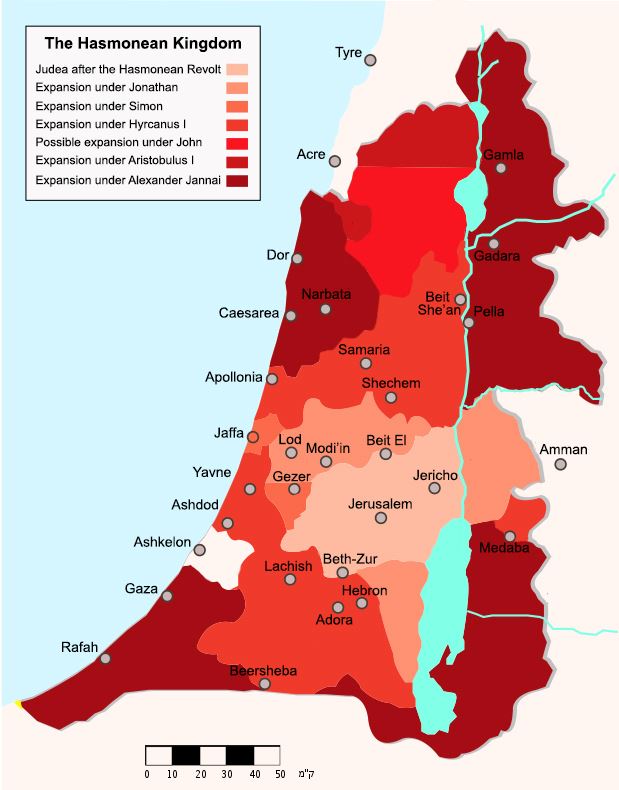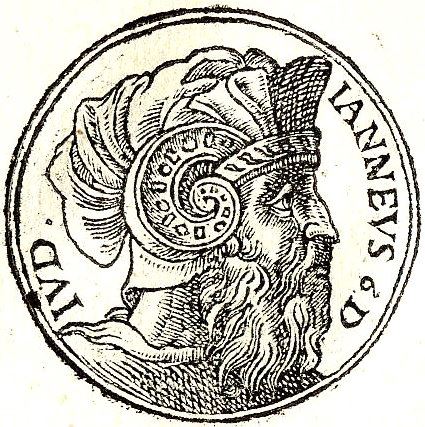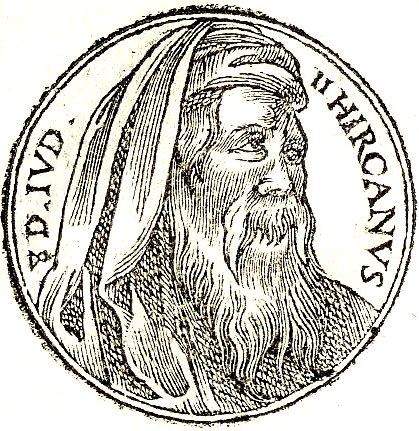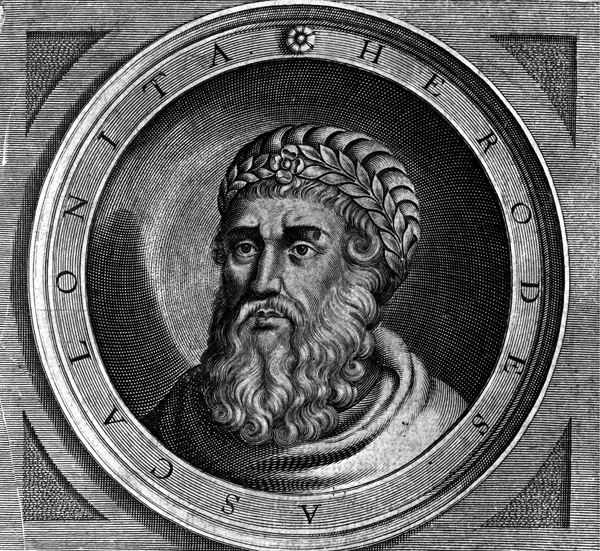The Hasmonean dynasty was a ruling dynasty of Judea and surrounding regions during classical antiquity.
Between c. 140 and c. 116 BCE the dynasty ruled Judea semi-autonomously from the Seleucids. From 110 BCE, with the Seleucid Empire disintegrating, the dynasty became fully independent, expanded into the neighbouring regions of Samaria, Galilee, Iturea, Perea, and Idumea, and took the title "basileus".
In 63 BC, the kingdom was invaded by the Roman Republic, broken up and set up as a Roman client state. The dynasty survived until 37 BC, where it was replaced by the Herodian dynasty. Shortly before Herod the Great died in 4 BC, Rome joined Judea, Samaria and Idumea into the Roman province of Iudaea.
Between c. 140 and c. 116 BCE the dynasty ruled Judea semi-autonomously from the Seleucids. From 110 BCE, with the Seleucid Empire disintegrating, the dynasty became fully independent, expanded into the neighbouring regions of Samaria, Galilee, Iturea, Perea, and Idumea, and took the title "basileus".
In 63 BC, the kingdom was invaded by the Roman Republic, broken up and set up as a Roman client state. The dynasty survived until 37 BC, where it was replaced by the Herodian dynasty. Shortly before Herod the Great died in 4 BC, Rome joined Judea, Samaria and Idumea into the Roman province of Iudaea.

John Hyrcanus was a Hasmonean - or Maccabeean - leader and Jewish high priest from 134 BC until his death in 104 BC). In rabbinic literature he is often referred to as Yoḥanan Cohen Gadol (יוחנן כהן גדול), "John the High Priest".
Judah Aristobulus I reigned c. 104 – 103 BC, and was the first ruler of the Hasmonean Dynasty to declare himself "king". He was the eldest of the five sons of John Hyrcanus, the previous leader.
Aristobulus was not only just the first king from the Hasmonean lineage, but the first of any Hebrew kings to claim both the high priesthood and the kingship title.
The Sadducees and...
Aristobulus was not only just the first king from the Hasmonean lineage, but the first of any Hebrew kings to claim both the high priesthood and the kingship title.
The Sadducees and...
Alexander Jannaeus was the second Hasmonean king of Judaea from 103 to 76 BC. A son of John Hyrcanus, he inherited the throne from his brother Aristobulus I, and married his brother's widow, Queen Salome Alexandra. From his conquests to expand the kingdom to a bloody civil war, Alexander's reign has been generalized as cruel and oppressive with never ending conflict.
The coinage of Alex...
The coinage of Alex...
John Hyrcanus II was for a long time the Jewish High Priest in the 1st century BCE. He was also briefly King of Judea 67–66 BCE and then the ethnarch (ruler) of Judea probably 47–40 BCE.
Hyrcanus was the eldest son of Alexander Jannaeus, King and High Priest, and Alexandra Salome. After the death of Alexander in 76 BC, his widow succeeded to the rule of Judea and installed her elder son...
Hyrcanus was the eldest son of Alexander Jannaeus, King and High Priest, and Alexandra Salome. After the death of Alexander in 76 BC, his widow succeeded to the rule of Judea and installed her elder son...
Salome Alexandra or Alexandra of Jerusalem, 141–67 BCE. The wife of Aristobulus I, and afterward of Alexander Jannaeus, she was the last queen of Judea, and the last ruler of ancient Judea to die as the ruler of an independent kingdom from 76 to 67 BCE.
Aristobulus II was the Jewish High Priest and King of Judea, 66 BC to 63 BC, from the Hasmonean Dynasty.
Aristobulus was the younger son of Alexander Jannaeus, King and High Priest, and Alexandra Salome. After the death of Alexander in 76 BC, his widow succeeded to the rule of Judea and installed her elder son Hyrcanus II as High Priest in 73 BC. When Salome died in 67 BC, Hyrcanus suc...
Aristobulus was the younger son of Alexander Jannaeus, King and High Priest, and Alexandra Salome. After the death of Alexander in 76 BC, his widow succeeded to the rule of Judea and installed her elder son Hyrcanus II as High Priest in 73 BC. When Salome died in 67 BC, Hyrcanus suc...
Herod I - often referred to as Herod the Great - was a Roman client king of Judea who ruled from 37–4 BC.
Herod's support from the Roman Empire was a major factor in enabling him to maintain his authority over Judea. There have been mixed interpretations concerning Herod's popularity during his reign. In The Jewish War, Josephus characterizes Herod's rule in generally favorable terms, a...
Herod's support from the Roman Empire was a major factor in enabling him to maintain his authority over Judea. There have been mixed interpretations concerning Herod's popularity during his reign. In The Jewish War, Josephus characterizes Herod's rule in generally favorable terms, a...
Antigonus II Mattathias also known as Antigonus the Hasmonean (died 37 BC) was the last Hasmonean king of Judea. A puppet king installed by the Parthians, he was the son of King Aristobulus II of Judea.
In 37 BC Herod handed him over to the Romans for execution, after Antigonus's three-year reign during which he led the Jews' fierce struggle for independence against the Romans.
In 37 BC Herod handed him over to the Romans for execution, after Antigonus's three-year reign during which he led the Jews' fierce struggle for independence against the Romans.
Herod Archelaus, 23 BC – c. 18 AD, was ethnarch of Samaria, Judea, and Idumea (biblical Edom), including the cities Caesarea and Jaffa, for a period of nine years (circa 4 BC to 6 AD).
Archelaus was removed by Roman Emperor Augustus when Judaea province was formed under direct Roman rule, at the time of the Census of Quirinius.
He was the son of Herod the Great and Malthace...
Archelaus was removed by Roman Emperor Augustus when Judaea province was formed under direct Roman rule, at the time of the Census of Quirinius.
He was the son of Herod the Great and Malthace...









